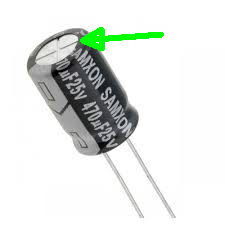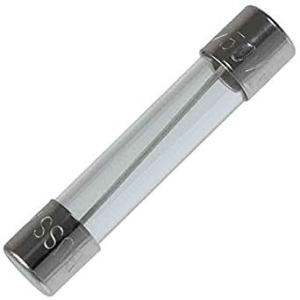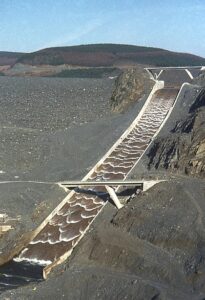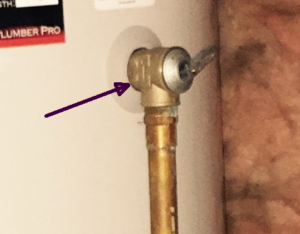



Okay, loyal readers, here is a quiz for you. These four things turn out to be exactly the same in a very important way.
(The green arrow points to a plus-shaped indentation on top of an electrolytic capacitor. The black arrow points to a thing that is mostly made of brass that is on the side of a water heater.)
Two, maybe three of them are actually pretty easy to make sense of, in terms of why they are exactly the same thing. But can you explain all four? Tomorrow I will post the answer.
Show off your nerd or geek chops, if you can, by posting a comment below in which you explain what each of the four things is exactly and why it is really very much the same thing as the other three things.

The dam spillway allows an overabundance of water to be safely released downstream instead of going over the top of the dam which could damage the dam.
Capacitor top vents if there is too much heat generated in the cap to allow the pressure to be safely released instead of blowing up.
The hot water heater pressure release allows pressure from a hot water heater to be safely released instead of blowing up the hot water heater.
The fuse stops the flow of current if there is too much current, keeping the wires (or load) from melting/catching fire/blowing up. It is a bit different than the other three in that it doesn’t divert the overload, but cuts it off instead. But it has the same effect of safely handling the overload condition.
First is a spillway, designed to prevent overfilling of a dam, and consequent damage by overflow; second is a fuse, designed to prevent excess current flow in a circuit, and consequent damage to current-sensitive items in that circuit; third (and I’m guessing here) if a deliberate weakness in the top of the capacitor designed to release pressure in a particular direction and prevent explosion of the capacitor, and consequent damage to its surroundings; and the last is a pressure relief valve designed to prevent overpressurization and explosion of the tank, and consequent damage to its surroundings. All are designed to prevent a comparatively large failure effectively by allowing a small one.
I’d characterize them as devices to provide relief from energy present in a medium at a level that is in excess of a safe or desired level. Funny, the thought process here feels like that of drafting a claim. A well written claim would arguably cover all of these.
The spillway, pressure relief valve and cross on the capacitor are all means for preventing the pressure of a fluid to exceed a value that would lead to catastrophic failure of the device that is protected. Without the safety device, the dam would burst, the capacitor would explode or the water heater would also explode. However, the fuse is different as it does not act mechanically. Yes, it is there to prevent catastrophic failure, as are the other three devices, but not by acting mechanically. So, in think that the “fourth thing”, as Carl calls it, is the fuse.
Just like John Hammond, I had the idea of looking at energy, and all 4 devices are indeed there to manage energy. However, the fuse differs markedly from the other devices in how energy is managed. Indeed, in the other three devices, once the energy accumulated in the system has exceeded a certain value, the energy will be released in a somewhat controlled manner. However, the fuse does not act in the same manner. The fuse is there to stop the FLOW of energy. That is, the fuse acts on the time derivative of energy, not energy itself. You can use your microwave oven for years, pumping hundreds of millions of Joules in your favorite snacks without any problem. The fuse that microwave ovens have (or at least used to have, it has been a while since I looked inside one) is there in case your microwave oven decides that it wants to use 3kW, and not the usual 1kW. The microwave oven could very well be brand new, never used to pump any energy into snacks, if you turn it on and defective components would allow for too much energy to flow in to the microwave oven, the fuse will blow within a very short amount of time.
The only thing I see is that could meet Carl’s idea of “similar” for the fuse and the other items is that as an analogy, voltage across a component is often seen as the equivalent of pressure, with current seen as the flow of something (electrons for example) under the action of this pressure. So, maybe what Carl is getting to is that if the “pressure”, in other words the difference in potential, between the two ends of the fuse gets too large, a large current will flow into the fuse, and the filament inside the fuse then melt to stop bad things from happening. This is what the other devices are doing as they will burst if the pressure (difference in “potential to do mechanical work”) between the inside of the reservoir/water heater/capacitor and the outside of the same devices becomes too large, the safety device is activated.
This is counter-intuitive as fuses, and circuit breakers, are often thought of as limiting current, not voltage. However, the only way to have a large current flowing into the fuse, which acts as a resistor until the filament melts, is to develop a large enough difference in potential between the two ends of the fuse. That is, the internal resistance (or impedance) of the fuse gets to be a larger fraction of the total resistance (or impedance) of the fuse+ whatever is connected to the fuse, as the total potential difference across “fuse+whatever is powered through the fuse” system is usually constant and set by the power source.
Of course, the fuse differs from the other devices in a very significant manner. In the other devices, energy flows though the device to relieve pressure. That is, energy starts flowing once the safety device is activated. In the fuse, energy stops flowing once the fuse is “activated”.
Each of the four things act as a “safety release” in response to a system variable exceeding an expected (design) maximum. These things also share the trait that they are not functionally essential to the normal operation of the systems they protect. Each is a “fail safe” that provides a “controlled failure” to thwart a catastrophic failure that might otherwise endanger both property and personnel.
Device:: Dam Spillway
Variable:: Water height
Prevention:: earth works breach due to falling water erosion
Method:: water above predetermined height bypassed to lower drainage canal
Device:: Circuit Fuse
Variable:: Current
Prevention:: fire / heat damage, premature failure
Method: open the circuit above predetermined current
Device:: Electrolytic Capacitor “Vent” (mechanical weak point)
Variable:: Pressure
Prevention:: explosive decompression
Method:: opening of can above predetermined pressure
Device:: Water Heater Temperature Pressure Relief Valve (TPRV)
Variable:: Temperature & Pressure
Prevention:: explosive decompression
Method:: release water / steam from tank above predetermined temperature / pressure thresholds